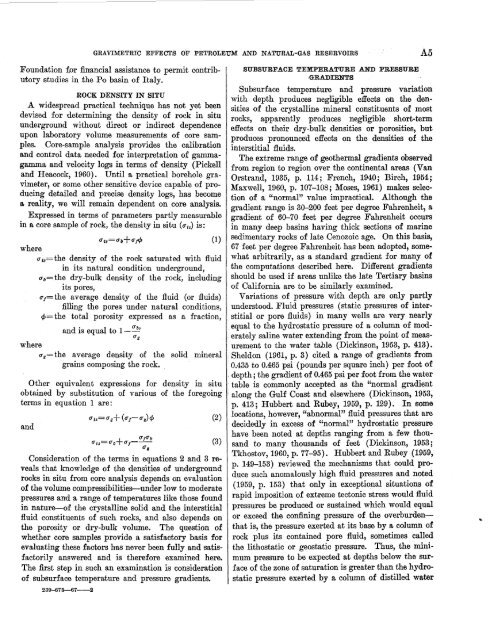Mass Properties of Sedimentary Rocks and Gravimetric Effects of ...
Mass Properties of Sedimentary Rocks and Gravimetric Effects of ...
Mass Properties of Sedimentary Rocks and Gravimetric Effects of ...
Create successful ePaper yourself
Turn your PDF publications into a flip-book with our unique Google optimized e-Paper software.
GRAVIMETRIC EFFECTS OF PETROLEUM AND NATURAL-GAS RESERVOIRS A5<br />
Foundation fpr financial assistance to permirt contributory<br />
studies in the Po basin <strong>of</strong> Italy.<br />
ROCK DENSITY IN SITU<br />
A widespread practical technique has not yet been<br />
devised for determining the density <strong>of</strong> rock in situ<br />
underground without direct or indirect dependence<br />
upon laboratory volume measurements <strong>of</strong> core samples.<br />
Core-sample analysis provides the calibration<br />
<strong>and</strong> control data needed for interpretation <strong>of</strong> gammagamma<br />
<strong>and</strong> velocity logs in terms <strong>of</strong> density (Pickell<br />
<strong>and</strong> Heacock, 1960). Until a praotical borehole gravimeter,<br />
or some other sensitive device capable <strong>of</strong> producing<br />
detailed <strong>and</strong> precise density logs, has become<br />
a reality, we will remain dependent on core analysis.<br />
Expressed in terms <strong>of</strong> parameters partly measurable<br />
in a core sample <strong>of</strong> rock, the density in situ Cuts) is:<br />
(I)<br />
where<br />
u,a=the density <strong>of</strong> the rock saturated with :fluid<br />
in its natural condition underground,<br />
u11=the dry-bulk density <strong>of</strong> the rock, including<br />
its pores,<br />
u1=the average density <strong>of</strong> the :fluid (or :fluids)<br />
filling the pores under natural conditions,<br />
=the total porosity expressed as a fraction,<br />
<strong>and</strong> is equal to 1-u 11 ,<br />
O"g<br />
where<br />
ug=the average density <strong>of</strong> the solid mineral<br />
grains composing the rock. .<br />
Other equivalent expressions for density in situ<br />
obtained by substitution <strong>of</strong> various <strong>of</strong> the foregoing<br />
terms in equation 1 are:<br />
<strong>and</strong><br />
+<br />
(2)<br />
O"fO"b ( )<br />
O"is=O"b u,-- 3<br />
Consideration <strong>of</strong> the terms in equations 2 <strong>and</strong> 3 reveals<br />
that knowledge <strong>of</strong> the densities <strong>of</strong> underground<br />
rocks in situ from core analysis depends on evaluation<br />
<strong>of</strong> the volume compressibilities-under low to moderate<br />
pressures <strong>and</strong> ·a range <strong>of</strong> temperatures like those found<br />
in nature-<strong>of</strong> the crystalline solid <strong>and</strong> the interstitial<br />
fluid constituents <strong>of</strong> such rocks, <strong>and</strong> also depends on<br />
the porosity or dry-bulk volume. The question <strong>of</strong><br />
whether core samples provide a satisfactory basis for<br />
evruluating these factors has never been fully <strong>and</strong> satisfactorily<br />
answered <strong>and</strong> is therefore examined here.<br />
The first step in such an examination is consideration<br />
<strong>of</strong> subsurface temperature <strong>and</strong> pressure gradients.<br />
239-675-67-· -2<br />
Ug<br />
SUBSURFACE TEMPERATURE AND PRESSURE<br />

















